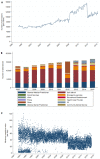Health record hiccups-5,526 real-world time series with change points labelled by crowdsourced visual inspection
- PMID: 37503960
- PMCID: PMC10375518
- DOI: 10.1093/gigascience/giad060
Health record hiccups-5,526 real-world time series with change points labelled by crowdsourced visual inspection
Abstract
Background: Large routinely collected data such as electronic health records (EHRs) are increasingly used in research, but the statistical methods and processes used to check such data for temporal data quality issues have not moved beyond manual, ad hoc production and visual inspection of graphs. With the prospect of EHR data being used for disease surveillance via automated pipelines and public-facing dashboards, automation of data quality checks will become increasingly valuable.
Findings: We generated 5,526 time series from 8 different EHR datasets and engaged >2,000 citizen-science volunteers to label the locations of all suspicious-looking change points in the resulting graphs. Consensus labels were produced using density-based clustering with noise, with validation conducted using 956 images containing labels produced by an experienced data scientist. Parameter tuning was done against 670 images and performance calculated against 286 images, resulting in a final sensitivity of 80.4% (95% CI, 77.1%-83.3%), specificity of 99.8% (99.7%-99.8%), positive predictive value of 84.5% (81.4%-87.2%), and negative predictive value of 99.7% (99.6%-99.7%). In total, 12,745 change points were found within 3,687 of the time series.
Conclusions: This large collection of labelled EHR time series can be used to validate automated methods for change point detection in real-world settings, encouraging the development of methods that can successfully be applied in practice. It is particularly valuable since change point detection methods are typically validated using synthetic data, so their performance in real-world settings cannot be assumed to be comparable. While the dataset focusses on EHRs and data quality, it should also be applicable in other fields.
Keywords: anomalies; change point detection; data quality; time series.
© The Author(s) 2023. Published by Oxford University Press GigaScience.
Conflict of interest statement
The author(s) declare that they have no competing interests.
Figures









References
-
- Huebner M, Vach W, le Cessie S. A systematic approach to initial data analysis is good research practice. J Thorac Cardiovasc Surg. 2016;151(1):25–7. - PubMed
Publication types
MeSH terms
Grants and funding
LinkOut - more resources
Full Text Sources
Medical

